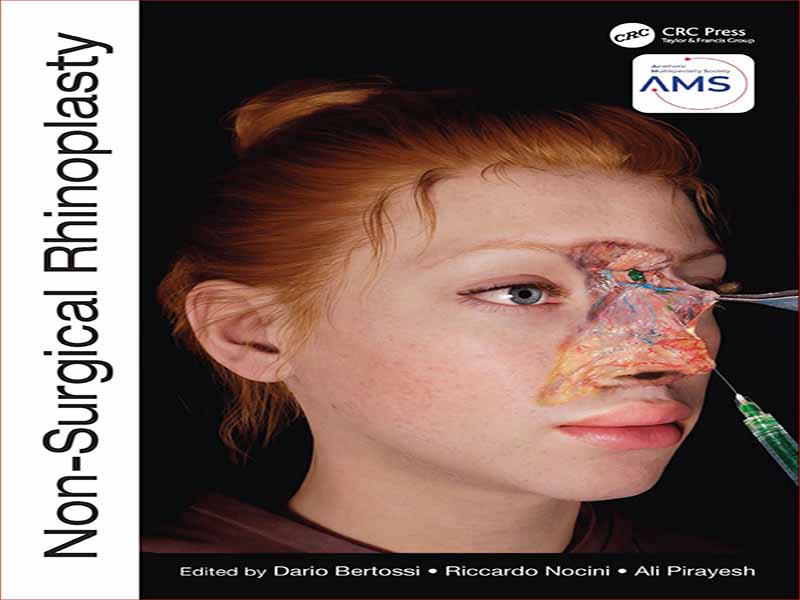- عنوان کتاب: Non-Surgical Rhinoplasty
- نویسنده: Dario Bertossi, MD
- حوزه: جراحی زیبایی, رینوپلاستی
- سال انتشار: 2023
- تعداد صفحه: 164
- زبان اصلی: انگلیسی
- نوع فایل: pdf
- حجم فایل: 33.9 مگابایت
زیبایی شناسی چهره به یک عامل پیشرو برای ارتباطات اجتماعی تبدیل شده است، زیرا چهره انسان را می توان خط مقدم هر مهارت ارتباطی، هدایت تصمیمات حیاتی و حرکت دادن نگرش هر فرد در پویایی رابطه در نظر گرفت. داشتن «نگاه جذاب» بیشترین اهمیت را در زندگی مدرن پیدا کرده است، زیرا جذابیت چهره انسان بر تعداد زیادی از جنبه های زندگی روزمره تأثیر می گذارد [1]. چهره همچنین بر چندین نشانه از عادات و باورهای فرهنگی مختلف در نوع بشر تأثیر میگذارد [2]، همانطور که در بسیاری از نظریههای اجتماعی شدن و تکامل انسانشناختی که اخیراً توسط لانگلویس و همکارانش بررسی شده است، به رسمیت شناخته شده است: «اثرات جذابیت چهره قوی است. و همهگیری، فراتر از برداشتهای اولیه غریبهها به تعاملات واقعی با کسانی که مردم میشناسند و مشاهده میکنند» [3، صفحه 404]. تا به امروز، نقش چهره در دنیای جهانی شده در مهارتهای ارتباطی برتری یافته است، بنابراین درک مفهومی ما از “زیبایی چهره” در سراسر تکامل سریع مد و عادات ناشی از گفتگوهای متقابل مکرر با فرهنگها و فرهنگهای مختلف حرکت میکند. خلق و خوی، حتی در سطح فیزیولوژی عصبی [4-11]. این امر تا به امروز منجر به حجم عظیمی از علایق و درخواستها برای اصلاح چهره خود به منظور هدف قرار گرفتن بهتر به مدلهای زیباییشناختی شده است که معمولاً از رهبران و افراد جذاب در بازار ارتباطات وام گرفته میشوند [12،13].
مفهوم زیبایی از دیدگاه عصب شناختی در کنار مفهوم تقارن قرار دارد. همان جذابیت یک چهره عمیقاً تحت تأثیر تقارن آن است، نسبت هماهنگی از بخشهای آناتومیکی، که به طور جمعی در مفهوم چیزی که یک چهره «ایدهآل» را نشان میدهد به اشتراک میگذارد [14-19]. در این زمینه، برخی از مناطق آناتومیکی صورت بسیار مهم هستند. به عنوان مثال، بینی با ارتباط آن با کل صورت و نمای ظاهری نقش اصلی را ایفا می کند.
درخواستها برای ایجاد تقارن ایدهآل یا تنظیم، اصلاح یا اصلاح عیوب در دنیای واقعی، بهویژه با جراحی بینی غیرجراحی، تا به امروز به شدت در حال افزایش است [20،21].
هر استراتژی فردی برای جراحی زیبایی بینی، سپتوپلاستی یا پروفپلاستی صورت یا سایر رویکردهایی که به طور کلی در اصطلاح “لیفت صورت” جمع آوری شده اند، ممکن است برای دستیابی به یک نمای زیبایی شناختی تمام صورت، حیاتی باشد، به خصوص اگر به یک فرآیند جوان سازی توجه شود. در دسترس بودن و مقرون به صرفه بودن روشهای غیرجراحی در زیباییشناسی صورت در سرتاسر جهان، بازار بزرگی از درمانهای زیبایی بینی را ایجاد کرده است که با پرس و جوی همزمان و کاملاً پراکسیسمال برای داشتن ظاهری جذاب تقویت شده است.
مطالعات تحقیقات بازار جهانی پیش بینی کرده است که ارزش بازار جراحی بینی در سال 2027 بیش از 2 میلیارد دلار خواهد بود که بیشتر آن در جراحی بینی غیر جراحی خواهد بود. اندازه بازار ایمپلنت های زیبایی بینی در سال 2020 700 میلیون دلار ارزش گذاری شده است و انتظار می رود با نرخ رشد سالانه مرکب (CAGR) 15.9 درصد بین سال های 2021 تا 2027 رشد کند، علی رغم شبکه های پیچیده درخواست ها/پیشنهادات در سراسر جهان، به دلیل زمینه های انگیزشی و فرهنگی [22-24].
آگاهی فردی از زیبایی در میان مردم، چه نوجوانان و چه بزرگسالان، در سراسر جهان در حال افزایش است. این اساساً یکی از عوامل مسبب اصلی است که باعث افزایش ارزش بازار می شود. بدیهی است که یک نگرش چندفرهنگی فزاینده، به ویژه در کشورهای غربی، برخی از هنجارهای زیبایی ارتدکس را اصلاح کرده است، بنابراین تقاضا برای ایمپلنت های غیر جراحی بینی، مانند فلرها، برای پلاستیک بینی افزایش یافته است. بعلاوه، فرهنگ فراگیر سلبریتی که دنیای واقعی ما را می سوزاند، جذابیت قابل توجهی بر مفهوم ایده آل زیبایی و خودآگاهی آن دارد، به ویژه اگر در کنار پذیرش عمومی استفاده از این روش ها با موفقیت باشد.
در نهایت، شایان ذکر است که این مفهوم تقویت شود که برخی از روشهای جراحی زیبایی بینی تا حد زیادی ملاحظات روانشناختی فرد را بهبود میبخشد و فرد را به سمت مزایای عاطفی و اجتماعی سوق میدهد. بنابراین، بازار جراحی بینی به طور گسترده ای پویایی پیچیده انتظارات از یک جهان به طور مداوم در حال تغییر و در حال توسعه را منعکس می کند.
Facial aesthetics has become a leading factor for social communication, as the human face can be considered the frontline of any relationship skill, leading crucial decisions and moving any individual’s attitude in the relation dynamics. Having an “appealing look” has gained the utmost importance in modern life, as the attractiveness of the human face impacts a huge number of daily life aspects [1]. Face affects also several hallmarks of the various cultural habits and beliefs in mankind [2], as it is recognized in many theories on socialization and anthropological evolution, recently reviewed by Langlois et al., as follows: “the effects of facial attractiveness are robust and pandemic, extending beyond initial impressions of strangers to actual interactions with those whom people know and observe” [3, page 404]. To date, the role of the face in the globalized world has achieved a primacy in communication skills, thus moving our conceptual perception of the “face beauty” throughout the rapid evolution of fashion and habits caused by the frequent cross-talks with different cultures and moods, even at the neurophysiological level [4–11]. This has lead, to date, to a huge amount of interests and requests to modify one’s own face in order to be better targeted to aesthetic models, usually borrowed from leaders and attractive people in the communication market [12,13].
The concept of beauty, from a neurological point of view, lies alongside the concept of symmetry. The same attractiveness of a face is deeply affected by its symmetry, a harmonious proportion of anatomical parts, collectively sharing the concept of what represents an “ideal” face [14–19]. In this context, some facial anatomical regions are particularly crucial; a leading role is exerted, for example, by the nose with its relationship with overall face and the profle.
Requests to ft the nose to an ideal symmetry or adjust, refne or correct imperfections are increasing hugely in the real world to date, particularly with non-surgical rhinoplasty [20,21].
Any individualized strategy for rhinoplasty, septoplasty or facial profleplasty or other approaches collectively gathered in the term “facelift”, may be critical to achieve a full-face aesthetic view, particularly if addressing a rejuvenating process. The enormous availability and affordability of non-surgical practices in facial aesthetics worldwide has generated a huge market of nasal aesthetic treatments, enhanced by the concurrent, quite paroxysmal, query to have an attractive look.
Global market research studies have forecasted that the rhinoplasty market will be worth over 2 billion dollars in 2027, most of which will be in non-surgical rhinoplasty. The size of the rhinoplasty implants market has been valued at 700 million dollars in 2020 and is expected to grow at a compound annual growth rate (CAGR) of 15.9% between 2021 and 2027, despite the complex networks of queries/offerings worldwide, due to motivational and cultural backgrounds [22–24].
An individual awareness of beauty is growing among people, both teenagers and adults, across the globe. This is essentially one of the leading causative factors moving ahead the market value. Obviously, a surging multiculturalist attitude, particularly in Western countries, has revised some orthodox beauty norms, thus increasing the demand for non-surgical rhinoplasty implants, such as fllers, for nose plastics. Moreover, the pervasive celebrity culture infating our real world has a signifcant appeal on the ideal concept of beauty and its self-consciousness, particularly if alongside public admissions of using these procedures with success.
Finally, it is noteworthy to strengthen the concept that certain rhinoplasty approaches greatly ameliorate one’s own psychological consideration, driving one to emotional and social benefts. The rhinoplasty market therefore widely refects the complex dynamics of expectations from a continuously changing and developing world.
این کتاب را میتوانید بصورت رایگان از لینک زیر دانلود نمایید.
Download: Non-Surgical Rhinoplasty



































نظرات کاربران